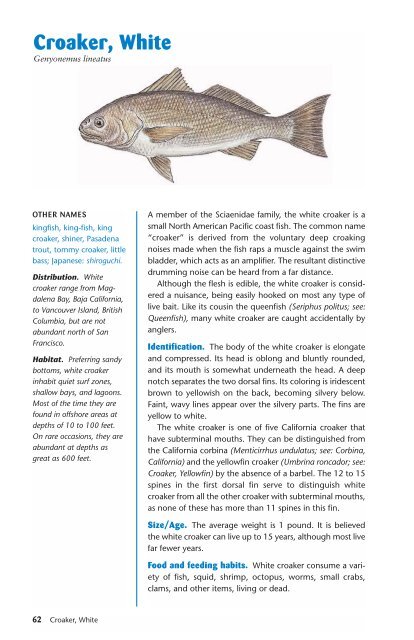Ken Schultz's Field Guide to Saltwater Fish - Macaw Pets store
Ken Schultz's Field Guide to Saltwater Fish - Macaw Pets store
Ken Schultz's Field Guide to Saltwater Fish - Macaw Pets store
You also want an ePaper? Increase the reach of your titles
YUMPU automatically turns print PDFs into web optimized ePapers that Google loves.
Croaker, White<br />
Genyonemus lineatus<br />
OTHER NAMES<br />
kingfish, king-fish, king<br />
croaker, shiner, Pasadena<br />
trout, <strong>to</strong>mmy croaker, little<br />
bass; Japanese: shiroguchi.<br />
Distribution. White<br />
croaker range from Magdalena<br />
Bay, Baja California,<br />
<strong>to</strong> Vancouver Island, British<br />
Columbia, but are not<br />
abundant north of San<br />
Francisco.<br />
Habitat. Preferring sandy<br />
bot<strong>to</strong>ms, white croaker<br />
inhabit quiet surf zones,<br />
shallow bays, and lagoons.<br />
Most of the time they are<br />
found in offshore areas at<br />
depths of 10 <strong>to</strong> 100 feet.<br />
On rare occasions, they are<br />
abundant at depths as<br />
great as 600 feet.<br />
62 Croaker, White<br />
A member of the Sciaenidae family, the white croaker is a<br />
small North American Pacific coast fish. The common name<br />
“croaker” is derived from the voluntary deep croaking<br />
noises made when the fish raps a muscle against the swim<br />
bladder, which acts as an amplifier. The resultant distinctive<br />
drumming noise can be heard from a far distance.<br />
Although the flesh is edible, the white croaker is considered<br />
a nuisance, being easily hooked on most any type of<br />
live bait. Like its cousin the queenfish (Seriphus politus; see:<br />
Queenfish), many white croaker are caught accidentally by<br />
anglers.<br />
Identification. The body of the white croaker is elongate<br />
and compressed. Its head is oblong and bluntly rounded,<br />
and its mouth is somewhat underneath the head. A deep<br />
notch separates the two dorsal fins. Its coloring is iridescent<br />
brown <strong>to</strong> yellowish on the back, becoming silvery below.<br />
Faint, wavy lines appear over the silvery parts. The fins are<br />
yellow <strong>to</strong> white.<br />
The white croaker is one of five California croaker that<br />
have subterminal mouths. They can be distinguished from<br />
the California corbina (Menticirrhus undulatus; see: Corbina,<br />
California) and the yellowfin croaker (Umbrina roncador; see:<br />
Croaker, Yellowfin) by the absence of a barbel. The 12 <strong>to</strong> 15<br />
spines in the first dorsal fin serve <strong>to</strong> distinguish white<br />
croaker from all the other croaker with subterminal mouths,<br />
as none of these has more than 11 spines in this fin.<br />
Size/Age. The average weight is 1 pound. It is believed<br />
the white croaker can live up <strong>to</strong> 15 years, although most live<br />
far fewer years.<br />
Food and feeding habits. White croaker consume a variety<br />
of fish, squid, shrimp, oc<strong>to</strong>pus, worms, small crabs,<br />
clams, and other items, living or dead.


